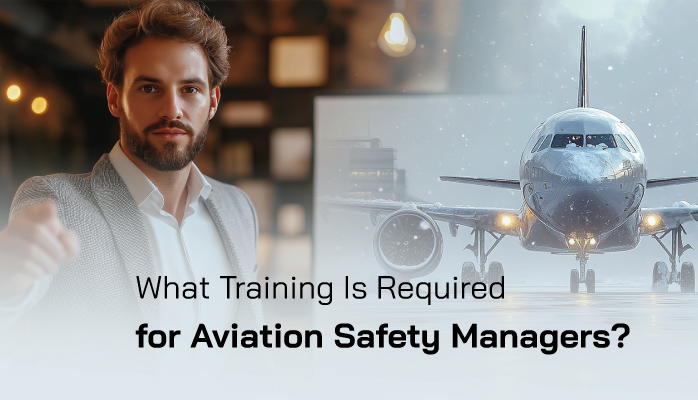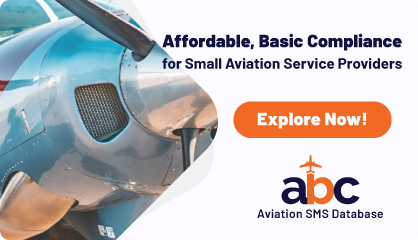Training Required for Aviation Safety Managers

Aviation safety managers play a critical role in ensuring the safety of
- aircraft operations,
- crew, and
- passengers.
Their responsibilities demand a deep understanding of regulatory compliance, risk management, and operational safety protocols. To excel in this role, safety managers must undergo comprehensive training that equips them with the necessary skills and knowledge.This article explores the essential training required for aviation safety managers, its importance, and how it contributes to a culture of safety in aviation.
Why Training Is Crucial for Aviation Safety Managers
Aviation is one of the most heavily regulated industries, with stringent safety standards set by organizations like the International Civil Aviation Organization (ICAO), Federal Aviation Administration (FAA), and European Union Aviation Safety Agency (EASA). Safety managers are tasked with ensuring compliance with these regulations while mitigating risks in dynamic and high-stakes environments. Proper training ensures they can:
- Identify and assess operational risks.
- Implement effective safety management systems (SMS).
- Stay updated on evolving regulations and industry best practices.
- Foster a proactive safety culture within their organization.
Without the right training, safety managers may struggle to address complex challenges, potentially compromising safety and regulatory compliance.
Core Training Requirements for Aviation Safety Managers
The training for aviation safety managers typically covers a blend of regulatory, technical, and leadership skills. Below are the key areas of focus:
1. Safety Management Systems (SMS) Training
SMS is the cornerstone of modern aviation safety. This structured approach to managing safety risks is mandated by ICAO and adopted by aviation authorities worldwide. SMS training equips safety managers with the ability to:
- Develop and implement an SMS tailored to their organization.
- Conduct risk assessments and hazard identification.
- Monitor safety performance through key performance indicators (KPIs).
- Promote a safety culture through employee engagement.
Recommended Courses:
- ICAO Safety Management Training
- FAA SMS Training Programs
- IATA Safety Management System Implementation Course
Related Aviation SMS Training Articles
- When Employees Need More Hazard Identification Training - Aviation SMS
- What Is Aviation Safety Training in Aviation SMS - Includes Videos to Use
- How to Automate Aviation SMS Training in 4 Steps Using Your Safety Program
2. Regulatory Compliance Training

Aviation safety managers must be well-versed in the regulations governing their operations. This includes understanding standards set by ICAO, FAA, EASA, and local aviation authorities. Training in this area covers:
- Airworthiness requirements.
- Operational regulations (e.g., Part 121, Part 135 for FAA).
- Incident and accident reporting protocols.
- Auditing and inspection processes.
Recommended Certifications:
- FAA Regulatory Compliance Training
- EASA Part-OPS and Part-M Training
- IOSA (IATA Operational Safety Audit) Training
3. Risk Management and Hazard Identification
Risk management is at the heart of an aviation safety manager’s role. Training in this area focuses on:
- Identifying potential hazards in flight operations, maintenance, and ground handling.
- Conducting root cause analyses using tools like the 5 Whys or Fishbone Diagram.
- Developing mitigation strategies to reduce risks.
- Using data-driven tools for predictive risk analysis.
Recommended Courses:
- IATA Aviation Risk Management Training
- ALPA Risk Management Workshops
- Embry-Riddle Aeronautical University Risk Assessment Courses
Related Aviation SMS Hazard Identification Articles
- 4 Pillars | What Is Hazard Identification in Aviation SMS
- 4 Tips to Approach Hazard Identification in Aviation SMS
- From Reactive to Proactive Hazard Identification in Aviation SMS
4. Human Factors and Crew Resource Management (CRM)
Human error is a leading cause of aviation incidents. Safety managers need training in human factors to understand how fatigue, stress, and communication breakdowns impact safety. CRM training teaches them to:
- Enhance teamwork and communication among crew members.
- Address human performance limitations.
- Implement strategies to reduce human error.
Recommended Programs:
- FAA Human Factors in Aviation Maintenance
- IATA Crew Resource Management Training
- EUROCONTROL Human Factors Training
5. Incident Investigation and Reporting
When incidents or accidents occur, safety managers must lead investigations to determine causes and prevent recurrence. Training in this area includes:
- Conducting thorough investigations using standardized methodologies.
- Preparing accurate and compliant incident reports.
- Collaborating with regulatory bodies like the NTSB or AAIB.
- Implementing corrective actions based on findings.
Recommended Courses:
- NTSB Accident Investigation Training
- IATA Incident Investigation and Reporting Course
- Cranfield University Aviation Safety Investigation Program
Related Articles on Incident Investigations
- How to Investigate Safety Issues
- Conducting Investigations in Aviation SMS Risk Management Scenarios
- Aviation Incident Investigations: Root Cause Analysis and Corrective Actions
6. Leadership and Communication Skills
Safety managers often lead teams and interact with stakeholders across the organization. Leadership training helps them:
- Build trust and credibility with employees.
- Communicate safety policies effectively.
- Drive organizational change to enhance safety culture.
- Manage conflicts and address resistance to safety initiatives.
Recommended Training:
- Dale Carnegie Leadership Training for Managers
- IATA Aviation Leadership Development
- Online leadership courses from platforms like Coursera or LinkedIn Learning
Specialized Training for Advanced Roles

Depending on the organization’s size and operations, safety managers may require additional training in specialized areas:
- Aviation Security Training: Understanding security protocols to address threats like terrorism or sabotage.
- Dangerous Goods Handling: Knowledge of regulations for transporting hazardous materials.
- Data Analytics for Safety: Using tools like Power BI or Tableau to analyze safety data and predict trends.
- Emergency Response Planning: Preparing for crises like aircraft accidents, fires or natural disasters.
Recommended Providers:
- IATA Training for Dangerous Goods
- Embry-Riddle Aeronautical University Emergency Response Courses
- Online data analytics bootcamps (e.g., Udemy, Coursera)
Continuous Professional Development
Aviation is a dynamic industry, with regulations, technologies, and best practices evolving rapidly. Safety managers must engage in continuous professional development (CPD) to stay current. This includes:
- Attending industry conferences like the NBAA Safety Forum or EASA Safety Conference.
- Participating in webinars and workshops hosted by aviation authorities.
- Subscribing to publications like Aviation Safety Magazine or Flight Safety Foundation reports.
- Earning advanced certifications, such as the IS-BAO (International Standard for Business Aircraft Operations) Auditor credential.
How to Choose the Right Training Program
When selecting training programs, safety managers should consider:
- Accreditation: Ensure the program is recognized by ICAO, FAA, or other relevant bodies.
- Delivery Format: Choose between in-person, online, or hybrid courses based on availability and learning preferences.
- Relevance: Select courses tailored to the organization’s operations (e.g., commercial airlines, business aviation, or cargo).
- Cost and Duration: Balance budget constraints with the depth of training required.
The Impact of Training on Aviation Safety
Well-trained safety managers are instrumental in reducing incidents, improving compliance, and fostering a safety-first culture. By investing in comprehensive training, organizations can:
- Enhance operational efficiency by minimizing disruptions.
- Reduce insurance premiums through demonstrated safety competence.
- Build trust with regulators, customers, and employees.
- Contribute to the industry’s overall safety record.
Conclusion
Becoming an effective aviation safety manager requires a robust foundation of training in
- safety management systems,
- regulatory compliance,
- risk management,
- human factors, and
- leadership.
Continuous learning and specialized training further enhance their ability to navigate the complexities of aviation safety. For aviation service providers, investing in their safety managers’ education is not just a regulatory necessity—it’s a strategic move to ensure safer skies and sustainable operations.
Ready to take your aviation safety career to the next level? Explore accredited training programs from providers like IATA, FAA, or Embry-Riddle, and stay ahead in this critical field.
Need tools to deliver training to employees? SMS Pro's Training & Qualifications Manager is available now.








